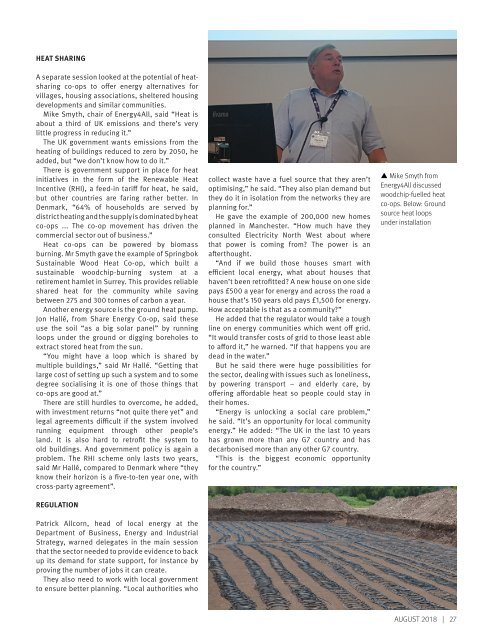AUGUST 2018
The August edition of Co-op News looks at how the co-operative movement can grow - but also thrive. Plus case studies from the US worker co-op movement, and how co-ops are embracing spoken word to tell the co-op story.
The August edition of Co-op News looks at how the co-operative movement can grow - but also thrive. Plus case studies from the US worker co-op movement, and how co-ops are embracing spoken word to tell the co-op story.
You also want an ePaper? Increase the reach of your titles
YUMPU automatically turns print PDFs into web optimized ePapers that Google loves.
HEAT SHARING<br />
A separate session looked at the potential of heatsharing<br />
co-ops to offer energy alternatives for<br />
villages, housing associations, sheltered housing<br />
developments and similar communities.<br />
Mike Smyth, chair of Energy4All, said “Heat is<br />
about a third of UK emissions and there’s very<br />
little progress in reducing it.”<br />
The UK government wants emissions from the<br />
heating of buildings reduced to zero by 2050, he<br />
added, but “we don’t know how to do it.”<br />
There is government support in place for heat<br />
initiatives in the form of the Renewable Heat<br />
Incentive (RHI), a feed-in tariff for heat, he said,<br />
but other countries are faring rather better. In<br />
Denmark, “64% of households are served by<br />
district heating and the supply is dominated by heat<br />
co-ops ... The co-op movement has driven the<br />
commercial sector out of business.”<br />
Heat co-ops can be powered by biomass<br />
burning. Mr Smyth gave the example of Springbok<br />
Sustainable Wood Heat Co-op, which built a<br />
sustainable woodchip-burning system at a<br />
retirement hamlet in Surrey. This provides reliable<br />
shared heat for the community while saving<br />
between 275 and 300 tonnes of carbon a year.<br />
Another energy source is the ground heat pump.<br />
Jon Hallé, from Share Energy Co-op, said these<br />
use the soil “as a big solar panel” by running<br />
loops under the ground or digging boreholes to<br />
extract stored heat from the sun.<br />
“You might have a loop which is shared by<br />
multiple buildings,” said Mr Hallé. “Getting that<br />
large cost of setting up such a system and to some<br />
degree socialising it is one of those things that<br />
co-ops are good at.”<br />
There are still hurdles to overcome, he added,<br />
with investment returns “not quite there yet” and<br />
legal agreements difficult if the system involved<br />
running equipment through other people’s<br />
land. It is also hard to retrofit the system to<br />
old buildings. And government policy is again a<br />
problem. The RHI scheme only lasts two years,<br />
said Mr Hallé, compared to Denmark where “they<br />
know their horizon is a five-to-ten year one, with<br />
cross-party agreement”.<br />
REGULATION<br />
Patrick Allcorn, head of local energy at the<br />
Department of Business, Energy and Industrial<br />
Strategy, warned delegates in the main session<br />
that the sector needed to provide evidence to back<br />
up its demand for state support, for instance by<br />
proving the number of jobs it can create.<br />
They also need to work with local government<br />
to ensure better planning. “Local authorities who<br />
collect waste have a fuel source that they aren’t<br />
optimising,” he said. “They also plan demand but<br />
they do it in isolation from the networks they are<br />
planning for.”<br />
He gave the example of 200,000 new homes<br />
planned in Manchester. “How much have they<br />
consulted Electricity North West about where<br />
that power is coming from? The power is an<br />
afterthought.<br />
“And if we build those houses smart with<br />
efficient local energy, what about houses that<br />
haven’t been retrofitted? A new house on one side<br />
pays £500 a year for energy and across the road a<br />
house that’s 150 years old pays £1,500 for energy.<br />
How acceptable is that as a community?”<br />
He added that the regulator would take a tough<br />
line on energy communities which went off grid.<br />
“It would transfer costs of grid to those least able<br />
to afford it,” he warned. “If that happens you are<br />
dead in the water.”<br />
But he said there were huge possibilities for<br />
the sector, dealing with issues such as loneliness,<br />
by powering transport – and elderly care, by<br />
offering affordable heat so people could stay in<br />
their homes.<br />
“Energy is unlocking a social care problem,”<br />
he said. “It’s an opportunity for local community<br />
energy.” He added: “The UK in the last 10 years<br />
has grown more than any G7 country and has<br />
decarbonised more than any other G7 country.<br />
“This is the biggest economic opportunity<br />
for the country.”<br />
p Mike Smyth from<br />
Energy4All discussed<br />
woodchip-fuelled heat<br />
co-ops. Below: Ground<br />
source heat loops<br />
under installation<br />
<strong>AUGUST</strong> <strong>2018</strong> | 27


















